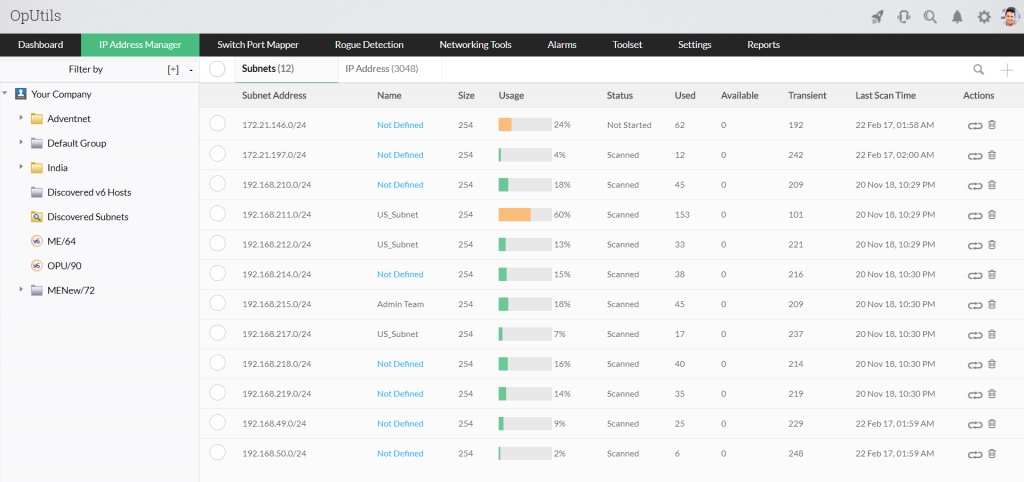
In todays IP-centric world, it’s becoming increasingly complex to support network-intensive adaptations like cloud adoption and bring your own device (BYOD) polices. As an IT admin, you’re responsible for scanning and tracking your IP resources to ensure that network devices and end users can be allocated unique IP addresses to access your network.
With hundreds of devices continuously connecting and disconnecting from your network, scanning your IP resources regularly is essential to ensure stable network availability. Using an effective IP scanner drives simplification and automation to ease IP resource management by helping you inspect the changing IP aspects, and troubleshooting issues as they arise.
In this post, we discuss the five key benefits of using an IP scanner for IP resource management and network inspection.
1. Enabling holistic scanning and data consistency of IP allocations
IPv4 addresses, IPv6 addresses, and subnets are crucial resources that provide the basic requirements for IP network communication. Any device must first be assigned a unique IP configuration to be able to connect and communicate in a network. This makes it important to keep track of the allocation, status, and availability of these resources with periodic scanning, logging, and alerting in case of resource exhaustion – using an advanced IP scanner.
Using an IP scanner enables you to scan your IPs and their allocations through a centralized console. It maintains consistency and accuracy by continually scanning and updating upon detecting when a new IP is provisioned or decommissioned. This ensures that the status of your IP resources displayed by the IP scanner is the real-time status of the IPs in your network.
An effective IP scanner enables you to scan the entire span of your network by supporting scanning across multiple IP address blocks and subnets. You can record your network’s IP provisioning details, gain visibility over to whom and when a particular IP is allocated, and the view aspects of the IP such as its reservation and its subnet with a network IP scanner.
2. Deriving a complete picture of your IP resource usage with an IP scanning software
As a network admin, gaining complete visibility over who is using your address space resources and how it’s being used enables you to keep track of your IP address availability and operations.
An IP scanner aids in associating your IP addresses to the devices or hosts using them, and also identifies their MAC addresses. It provides comprehensive insights into the networking aspects of the device, such as its network interface card type, reservation status, switch port, asset details, or last scan time, and can drill down to details such as its physical location or the system name of the device currently using the IP.
Periodic scanning of the network via automated IP scan schedules offers an effective way to monitor IP resources, and ensures the accuracy of your IP inventory.
3. Increasing network performance by optimizing IP space fragmentation and utilization
Subnetting IP address space maximizes the speed and effectiveness of communication and network operations of entities within subnets. Complex organizational networks are often made up of multiple subnets, and each subnet consists of a pool of IP addresses that are assigned to various devices and hosts.
Scanning and monitoring these subnets is simplified by using an IP scanner tool. It allows you to scan across multiple subnets, enabling you to track and log the subnet performance metrics. View a comprehensive summary of subnet utilization, such as the total number of IPs in a subnet, the IPs that are currently available, and the DNS address resolution status of IPs.
IP scan results allow you to analyze the utilization of your network subnets, and plan your network infrastructure accordingly to use the IP addresses within the subnets optimally. This ensures that no subnet is underutilized, and no subnet is overutilized to cause a resource exhaustion.
4. Managing dynamic networks by monitoring IP status changes
Static IP allocation is where a network entity is manually assigned a particular IP address and is not subjected to change unless manually configured. But with networks scaling to adapt to hundreds of devices entering and leaving at the same time, dynamic allocations have been adopted. With dynamic allocations, it’s imperative to rigorously scan and monitor your IP status, and plan networking accordingly to avoid running out of IP addresses.
An IP scanner aids you in this task by displaying the real-time address utilization statistics across subnets, and allows you to log the historical operational status of IP addresses. It provides a comprehensive summary of address space usage, scan status, and availability, as well as a list of the scanned IPs details including IPs that are available, used, or in a transient state. You can also reserve IPs for particular devices.
5. Staying ahead of IP resource exhaustion and capacity planning
Enterprise networks aren’t limited to a finite set of IP addresses and subnets. These networks scale continually to include a large number of devices and hosts that fulfill the networking requirements. This means you’ll be adding more IP address blocks to support your expanding network infrastructure.
Despite the best planning efforts, IP address requirements rise and fall depending on the circumstances. With an IP scanner, you can plan your address space requirements in advance with comprehensive, IP-specific reports that can be used to analyze the pattern of utilization of your IP address space. An IP scanner can be configured to generate threshold-based alerts that notify you whenever an IP issue, such as potential IP address space exhaustion, is detected in the network.
OpUtils: An IP scanner that works for you
ManageEngine OpUtils offers comprehensive insights and control over your IP inventory, and end-to-end network resource connectivity. It enables you to manage complex network infrastructure supporting BYOD policies, and vital DNS and DHCP servers from an intuitive, code-free console.
OpUtils’ IP scanning, tracking, and management capabilities can:
- Enable IPv4 and IPv6 address space management in a single console.
- Pull a comprehensive summary of network IPs that provide full visibility into their status.
- Conduct real-time scans spanning the entire network, including multiple subnets and IP address blocks.
- Create automated IP scan schedules that are triggered periodically to obtain an accurate summary of address space utilization and performance metrics.
- Conduct network audits easily with advanced port scanning widgets that provide crucial data at a glance.
- Pull out operational history of network IPs.
- Generate threshold-based alerts to escalate emerging problems.
- Audit IP address performance metrics with diverse, granular reports.
- Troubleshoot network issues with IP tools such as Ping and Traceroute.

That’s not all! OpUtils is an unified IP address management and switch port mapping solution that offers IP address tracking, switch port mapping, rogue detection, and over 30 network tools including Wake on LAN for remote booting.
New to ManageEngine OpUtils? Schedule a live demo with a product expert who will walk you through all the features of OpUtils, or download a 30-day free trial to learn hands-on how OpUtils can enhance your IP address and switch port management strategy.

